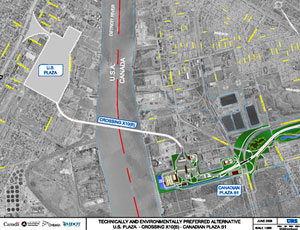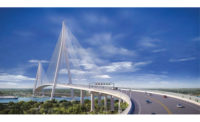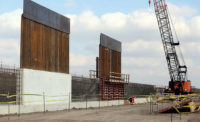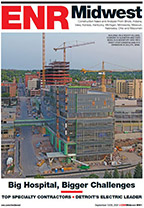The Michigan Dept. of Transportation will find out on March 17 how many developers, investors, lenders, design-build contractors and operators are interested in building a new $2.26-billion international bridge linking Detroit and Windsor, Ontario, Canada. That’s the final day for interested private-sector companies and teams to respond to a request for proposal of interest (RFPOI) sent out in late January.
MDOT will use the non-binding responses in its May 1 report to the Michigan Legislature, asking it to authorize construction of the bridge, create a tolling authority and allow the creation of a public-private partnership to build and run the bridge.
The proposed Detroit River International Crossing (DRIC) Project would consist of five components: a $451-million interchange to Interstate 75 in Detroit, a $474-million U.S. inspection plaza in Detroit, a new $812-million bridge over the Detroit River, a $532-million Canadian inspection plaza in Windsor, and an access freeway connecting the Windsor plaza to Highway 401 in Ontario. The first four components are included in the proposal. The fifth—the Canadian access freeway connecting the Windsor plaza to Highway 401, called the Windsor Essex Parkway—is being developed and constructed separately.
MDOT, the U.S. Federal Highway Administration, Transport Canada and the Ontario Ministry of Transportation are partnering on the project. The group’s RFPOI says the bridge is needed to provide new border-crossing capacity to meet long-term demand as well as an additional crossing in case of disruption at the area’s other crossings. The most notable of those is the privately owned, 80-year-old Ambassador Bridge, about two miles upriver from the proposed site of the new bridge.
An investment-grade traffic study released in February shows that about 34,600 vehicles per day would use the new bridge by 2035. “This new study not only confirms the importance of the existing international crossing but also reaffirms the need for a new crossing in the Detroit-Windsor corridor within the next five to 10 years in order to support trade between the U.S. and Canada,” says Michigan Transportation Director Kirk T. Steudle.
Steudle says the DRIC group would like to finance the project through some form of public-private partnership (P3). “At this point, we are considering a model that would incorporate some participation by the private sector in financing, design, construction, engineering and maintenance,” he says.
The project would be Michigan’s first P3. Mohammed Alghurabi, MDOT’s senior project manager for the DRIC project, says studying similar large global projects convinced the group that a P3 was the way to go. “It brings together the resources of the private and the public sectors for a better result,” he notes. The financial arrangement would also help conserve Michigan’s bonding capacity.
The bridge itself would be an impressive structure. The RFPOI says it could be either a suspension bridge or a cable-stayed design; potential contractors will be asked to recommend which type of bridge to build. In either case, no piers will be constructed in the river. The concept for the cable-stayed design shows a main span of 2,756 ft, while the suspension-bridge design has a span of 2,805 ft. Pylons for the cable-stayed bridge would rise 835 ft above their footings. Towers for the suspension bridge would reach 459 ft. With either design, the bridge deck would carry three lanes of traffic in each direction and have space for adding a fourth lane each way.






Post a comment to this article
Report Abusive Comment